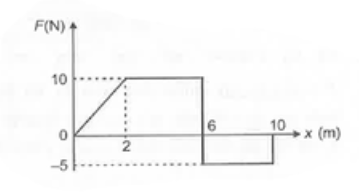Referring to a−s diagram as shown in , findthe velocity of the particle when the particle when the spaarticle justcovers 20m, (v0=√50ms−1.
 .
.
The correct Answer is:√350ms−1
a=−s4+10⇒v∫v0dvds=−s4+10
⇒v∫v0vdv=20∫0(−s(ds)+10ds
⇒v2−v202=[−s28+10s]200
⇒v2−502=[−s28+10s]200.
Topper's Solved these Questions
- KINEMATICS-1BOOK - CENGAGE PHYSICS ENGLISHCHAPTER - KINEMATICS-1EXERCISE - Single Correct
52 Videos
- KINEMATICS-1BOOK - CENGAGE PHYSICS ENGLISHCHAPTER - KINEMATICS-1EXERCISE - Graphical Concept
17 Videos
- KINEMATICS-1BOOK - CENGAGE PHYSICS ENGLISHCHAPTER - KINEMATICS-1EXERCISE - Exercise 4.4
16 Videos
- GRAVITATIONBOOK - CENGAGE PHYSICS ENGLISHCHAPTER - GRAVITATIONEXERCISE - INTEGER_TYPE
1 Videos
- KINEMATICS-2BOOK - CENGAGE PHYSICS ENGLISHCHAPTER - KINEMATICS-2EXERCISE - Exercise Integer
9 Videos
Similar Questions
Referring a−s diagram in the figure , find the velocity after particle travel 250m from starting. Assume v0=0.
 .
.
View SolutionReferring to a−x graph, find the velocity when thedisplacement of the particle is 100m. Assume intial velocity as zero.
 .
.
View SolutionIf v=x2−5x+4, find the acceleration of the particle when velocity of the particle is zero.
View SolutionThe acceleration-displacement graph of a particle moving in a straight line is as shown in figure, initial velocity of particle is zero. Find the velocity of the particle when displacement of the particle is s=12m.

View SolutionThe acceleration of a particle which moves along the positive x-axis varies with its position as shown in figure. If the velocity of the particle is 0.8ms−1 at x = 0, then velocity of the particle at x=1.4m is (∈ms−1).

View SolutionA particle of mass m moves along line PC with velocity v as shown. What is the angular momentum of the particle about O?

View SolutionRefering to v−s diagram, find:
 .
.
a. Acceleration of the particle when its velocity becomes half of the initial velocity.
b. Total distance covered by the particle.
View SolutionA particle slides with a speed of 3ms−1 at P. When it reaches Q,it acquires a speed of 4ms−1 after describing an angle of 60∘ at O as shown in figure .Find the changes in the velocity of the particle between P and Q. Assume that the path followed by the particle is circular from P to Q

View SolutionThe force versus position (F-x) graph of a particle of mass 2 kg is shown in the figure. If at x = 0 velocity of particle is 2 m/s then velocity of the particle at x = 8 m will be

View SolutionA big particle of mass (3+m) kg blasts into 3 pieces , such that a particle of mass 1 kg moves along x - axis , with velocity 2ms−1 and a particle of mass 2 kg moves with velocity 1ms−1 perpendicular to direction of 1 kg particle . If the third particle moves with velocity √2ms−1, then m is
View Solution
